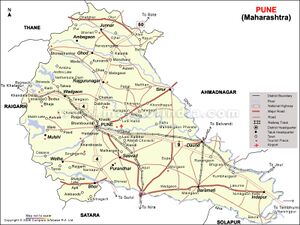Inamgaon
| Author:Laxman Burdak, IFS (R) |

Inamgaon (इनामगांव) is a post-Harappan agrarian village and archaeological site in Pune district of Maharashtra.
Contents
Variants
Location
The village is located approximately 89 kms to the east of the city of Pune. The region, situated within the lower reaches of the Ghod River. Situated along the right bank of the Ghod River, it is considered to be the 'regional centre' of the Bhima Valley.[1]
History
Inamgaon is one of the most intensively and extensively excavated and well reconstructed Chalcolithic sites of the Deccan region as well as of India so far.
Archaeological site
An ancient site, measuring approximately 550 metres by 430 metres , is located about 3 kms from Inamgaon. There are five mounds at the site. The largest mound is called 'Inamgaon I', and it has been extensively excavated, and studied for its archaeological finds.[2]The site was occupied between 3800-3200 B.P. (calibrated), or 1800-1200 BC.
The Chalcolithic settlement was excavated in order to better understand the early and later Jorwe culture.[3] There are 3 phases of the Chalcolithic that are found at Inamgaon.
The excavation was a landmark in India's archaeology history due to its extensive and systematic process.[4] The excavations revealed multiple cultural phases including Late Jorwe Culture, Early Jorwe Culture, and Malwa Culture. Archaeology findings are available at different museums such as Deccan College Post-Graduate and Research Institute, and Chhatrapati Shivaji Maharaj Vastu Sangrahalaya [5]
Ahar, Kayatha, and Malwa cultures
Dr Naval Viyogi[6] writes about The South and the Central Indian Cultures of Chalcolithic Age: (Ahar, Kayatha, and Malava) ...The remains of Chalcolithic culture have been recovered from the excavation of Ahar and Gelund sites of Bana valley in Rajasthan [7]The date of this culture is 2000 BC-500 BC. Later it was occupied by the 'Iron Age People'. The latest Carbon date of Kalibanga has been calculated to be 1500 B.C. It means Harappan culture survived there later, for a period of about 300 years. In this way Harappan culture of Kalibanga and Chalcolithic culture of Ahar lived contemporarily for a long period of about 700 years (2000 BC-1300 BC). The date 1725 BC, derived by the Tata Institute of Technology Bombay, is also not less contemporary. Since the carbon dates of Eran (Distt Sagar Madhya Pradesh), Navadatoli (Distt Nimad in Madhya Pradesh), Nevasa (Distt Ahmad Nagar), Songaon, Inamgaon Chandoli (Distt Pune M.R.) etc have been fixed within the second millenium B.C. From this it has become clear that Chalcolithic culture developed in the South and the Central India[8] during the last period of Harappan culture or last phase of some sites or just after.
In this age, the successive development of three cultures of Kayatha, Malava and Jorve is also evident. The Savalda culture of Tapti valley is of some specific type, but it is similar to Kayatha culture. Remains of whatever Chalcolithic culture have come to hands from Maheshwara and Navadatoli (9 kms South of Indore) lying in between Ujjain and Indore, has been named as Malava culture. On a later date, from excavation of Kayatha (on the bank of Kali Sindh) we have come to know about a rich Chalcolithic culture, which developed a few centuries (about 2000 BC) earlier than the Malava culture. Ahar, Kayatha and Malava cultures are so similar that it will be Justified to call them fundamentally one culture. The Ahar and the Kayatha cultures should be taken as parent cultures of Malava[9].
Owing to fixation of carbon-14 date[10] of Malva culture between 1660 ± 130 and 1445 ± 130 BC, period of its origin has been decided 1500 BC (Aggarwal-l971). Evidences of extension of this culture from the region of Ujjain and Navadatoli up to the Tapti and onward up to the Bhima valley, has been noted from the excavation of Chandoli, Songaon and Inamgaon.[11]
External links
References
- ↑ Dutta, Anwita (2006). "A Critical Review of the Economy of the Chalcolithic People of Inamgaon". Ancient Asia. 1: 123. doi:10.5334/aa.06111.
- ↑ Lukacs, John R.; Rebecca K. Bogorad, Subhash R. Walimbe & Donald C. Dunbar (September 1986). "Paleopathology at Inamgaon: A Post-Harappan Agrarian Village in Western India". Proceedings of the American Philosophical Society. 130 (3): 289–311. JSTOR 986828. PMID 11620956.
- ↑ SANKALIA, H. D.; D. ANSARI & M. K. DHAVALIKAR (1971). "Inamgaon: A Chalcolithic Settlement in Western India" (PDF). Asian Perspectives. XIV: 140.
- ↑ Dutta, Anwita (2006). "A Critical Review of the Economy of the Chalcolithic People of Inamgaon". Ancient Asia. 1: 123. doi:10.5334/aa.06111.
- ↑ https://incrediblehealthtips.com/pregnancy/news/Inamgaon.html
- ↑ Dr Naval Viyogi: Nagas – The Ancient Rulers of India, p.57
- ↑ Dr. Madan Mohan Singh, "Puratatva Ki Ruprekha" (1989), p.54
- ↑ Dr. Madan Mohan Singh, "Puratatva Ki Ruprekha" (1989), p.56
- ↑ ibid
- ↑ Dr. Madan Mohan Singh, "Puratatva Ki Ruprekha" (1989), p.57
- ↑ ibid